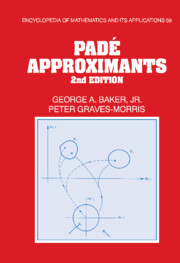Book contents
- Frontmatter
- Contents
- Preface
- Preface to the first edition
- 1 Introduction and definitions
- 2 Elementary developments
- 3 Padé approximants and numerical methods
- 4 Connection with continued fractions
- 5 Stieltjes series and Pólya series
- 6 Convergence theory
- 7 Extensions of Padé approximants
- 8 Multiseries approximants
- 9 Connection with integral equations and quantum mechanics
- 10 Connection with numerical analysis
- 11 Connection with quantum field theory
- Appendix: A FORTRAN FUNCTION
- Bibliography
- Index
11 - Connection with quantum field theory
Published online by Cambridge University Press: 29 September 2009
- Frontmatter
- Contents
- Preface
- Preface to the first edition
- 1 Introduction and definitions
- 2 Elementary developments
- 3 Padé approximants and numerical methods
- 4 Connection with continued fractions
- 5 Stieltjes series and Pólya series
- 6 Convergence theory
- 7 Extensions of Padé approximants
- 8 Multiseries approximants
- 9 Connection with integral equations and quantum mechanics
- 10 Connection with numerical analysis
- 11 Connection with quantum field theory
- Appendix: A FORTRAN FUNCTION
- Bibliography
- Index
Summary
Perturbed harmonic oscillators
This chapter consists of three sections. In the first section, we discuss the arguments which lead us to think that Padé approximants are an important tool for the summation of the perturbation expansions of quantum field theories. In the second section, we discuss two exemplary models of pion–pion scattering in which Padé approximants have revitalized the prospects of perturbation theory. In the last section we give a flavor of the application of Padé methods to critical phenomena and indicate how this subject relates to field theory.
We cannot adequately summarize here the many books on quantum theory. The relevant background of quantum mechanics used in this section is given in The Principles of Quantum Mechanics [Dirac, 1958]. Elementary field theory and quantum electrodynamics are described by Schweber [1961]; we refer especially to the Cargèse Lectures in Physics [Bessis, 1972] for an advanced treatment of the relevant background of quantum field theory.
The world of quantum electrodynamics (QED) is the world of photons and electrons. The vacuum is postulated to be the lowest energy state. A basic feature of QED is the possibility of the formation of virtual electron–positron pairs. This phenomenon is the origin of vacuum polarization, which has a measurable and accurately verified effect on the energy levels of atomic hydrogen. Exploding black holes may be a more dramatic realization of this effect. Dyson [1952] considered a configuration of many nearby electrons and, some distance away, as many nearby positrons. We show an example in Figure 11.1.
Information
- Type
- Chapter
- Information
- Padé Approximants , pp. 674 - 689Publisher: Cambridge University PressPrint publication year: 1996
